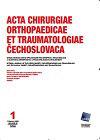[Surgical Treatment of Degenerative Lumbar Stenosis and Spondylolisthesis: Clinical Practice Guideline].
IF 0.4
4区 医学
Q4 ORTHOPEDICS
Acta chirurgiae orthopaedicae et traumatologiae Cechoslovaca
Pub Date : 2023-06-22
DOI:10.55095/achot2023/021
引用次数: 0
Abstract
PURPOSE OF THE STUDY This article presents the evidence and the rationale for the recommendations for surgical treatment of degenerative lumbar stenosis (DLS) and spondylolisthesis that were recently developed as a part of the Czech Clinical Practice Guideline (CPG) "The Surgical Treatment of the Degenerative Diseases of the Spine". MATERIAL AND METHODS The Guideline was drawn up in line with the Czech National Methodology of the CPG Development, which is based on the Grading of Recommendations, Assessment, Development and Evaluation (GRADE) approach. We used an innovative GRADE-adolopment method that combines adoption and adaptation of the existing guidelines with de novo development of recommendations. In this paper, we present three adapted recommendations on DLS and a recommendation on spondylolisthesis developed de novo by the Czech team. RESULTS Open surgical decompression in DLS patients has been evaluated in three randomized controlled trials (RCTs). A recommendation in favour of decompression was made based on a statistically significant and clinically evident improvement in the Oswestry Disability Index (ODI) and leg pain. Decompression may be recommended for patients with symptoms of DLS in the event of correlation of significant physical limitation and the finding obtained via imaging. The authors of a systematic review of observational studies and one RCT conclude that fusion has a negligible role in the case of a simple DLS. Thus, spondylodesis should only be chosen as an adjunct to decompression in selected DLS patients. Two RCTs compared supervised rehabilitation with home or no exercise, showing no statistically significant difference between the procedures. The guideline group considers the post-surgery physical activity beneficial and suggests supervised rehabilitation in patients who have undergone surgery for DLS for the beneficial effects of exercise in the absence of known adverse effects. Four RCTs were found comparing simple decompression and decompression with fusion in patients with degenerative lumbar spondylolisthesis. None of the outcomes showed clinically significant improvement or deterioration in favour of either intervention. The guideline group concluded that for stable spondylolisthesis the results of both methods are comparable and, when other parameters are considered (balance of benefits and risks, or costs), point in favour of simple decompression. Due to the lack of scientific evidence, no recommendation has been formulated regarding unstable spondylolisthesis. The certainty of the evidence was rated as low for all recommendations. DISCUSSION Despite the unclear definition of stable/unstable slip, the inclusion of apparently unstable cases of DS in stable studies limits the conclusions of the studies. Based on the available literature, however, it can be summarized that in simple degenerative lumbar stenosis and static spondylolisthesis, fusion of the given segment is not justified. However, its use in the case of unstable (dynamic) vertebral slip is undisputable for the time being. CONCLUSIONS The guideline development group suggests decompression in patients with DLS in whom previous conservative treatment did not lead to improvement, spondylodesis only in selected patients, and post-surgical supervised rehabilitation. In patients with degenerative lumbar stenosis and spondylolisthesis with no signs of instability, the guideline development group suggests simple decompression (without fusion). Key words: degenerative lumbar stenosis, degenerative spondylolisthesis, spinal fusion, Clinical Practice Guideline, GRADE, adolopment.退行性腰椎管狭窄和腰椎滑脱的手术治疗:临床实践指南。
研究目的:本文介绍了退行性腰椎管狭窄症(DLS)和腰椎滑脱手术治疗建议的证据和基本原理,这些建议最近作为捷克临床实践指南(CPG)的一部分而发展起来。脊柱退行性疾病的外科治疗材料和方法该指南是根据捷克国家CPG发展方法制定的,该方法基于建议、评估、发展和评价分级(GRADE)方法。我们采用了一种创新的grade -采用方法,将现有指南的采用和调整与建议的重新开发相结合。在本文中,我们提出了三个关于DLS的改编建议和一个由捷克团队重新开发的关于脊柱滑脱的建议。结果:三个随机对照试验(RCTs)对DLS患者的开放手术减压进行了评估。基于统计学上显著和临床上明显的改善Oswestry残疾指数(ODI)和腿部疼痛,提出了赞成减压的建议。对于有DLS症状的患者,如果有明显的身体限制和影像学发现相关,可以推荐减压。一项观察性研究的系统综述和一项随机对照试验的作者得出结论,在单纯性DLS病例中,融合的作用可以忽略不计。因此,在选定的DLS患者中,椎体融合术只能作为减压的辅助手段。两项随机对照试验比较了有监督的康复与在家或不运动,结果显示两种方法之间没有统计学上的显著差异。指南小组认为术后体育活动是有益的,并建议在没有已知不良反应的情况下,对接受DLS手术的患者进行监督康复,以获得运动的有益效果。四项随机对照试验比较了退行性腰椎滑脱患者的单纯减压和减压融合。两种干预措施均未显示有临床意义的改善或恶化。指南小组得出结论,对于稳定性滑脱,两种方法的结果是可比较的,当考虑到其他参数(利益和风险的平衡,或成本)时,倾向于简单减压。由于缺乏科学证据,目前还没有针对不稳定性椎体滑脱的建议。所有建议的证据的确定性都被评为低。尽管稳定/不稳定滑移的定义不明确,但在稳定研究中纳入明显不稳定的DS病例限制了研究的结论。然而,根据现有的文献,可以总结出,在单纯性退行性腰椎管狭窄和静态腰椎滑脱中,给定节段的融合是不合理的。然而,目前它在不稳定(动态)椎体滑移的情况下的应用是无可争议的。结论:指南制定小组建议,对于先前保守治疗未导致改善的DLS患者进行减压,仅在选定的患者中进行脊椎膨胀性手术,并在术后监督下进行康复。对于没有不稳定迹象的退行性腰椎管狭窄和腰椎滑脱患者,指南制定组建议简单减压(不融合)。关键词:退行性腰椎管狭窄,退行性腰椎滑脱,脊柱融合术,临床实践指南,GRADE,发展。
本文章由计算机程序翻译,如有差异,请以英文原文为准。
求助全文
约1分钟内获得全文
求助全文
来源期刊
CiteScore
0.70
自引率
25.00%
发文量
53
期刊介绍:
Editorial Board accepts for publication articles, reports from congresses, fellowships, book reviews, reports concerning activities of orthopaedic and other relating specialised societies, reports on anniversaries of outstanding personalities in orthopaedics and announcements of congresses and symposia being prepared. Articles include original papers, case reports and current concepts reviews and recently also instructional lectures.

 求助内容:
求助内容: 应助结果提醒方式:
应助结果提醒方式:


